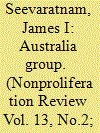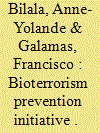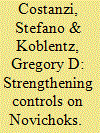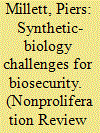|
|
|
Sort Order |
|
|
|
Items / Page
|
|
|
|
|
|
|
| Srl | Item |
| 1 |
ID:
075783


|
|
|
|
|
| Publication |
2006.
|
| Summary/Abstract |
The Australia Group's (AG's) contributions toward stemming global proliferation of chemical and biological weapons of mass destruction over the last 20 years are noted, in addition to the group's complementary role in effectively supporting the purpose and objectives of the Chemical Weapons Convention (CWC). This report also outlines the organizational and operational means that help accomplish the AG mission and notes the U.S. Congress' recognition of the role of the AG in countering chemical and biological weapons proliferation. Addressing criticism by some CWC states parties that question the AG's role in nonproliferation, the author also highlights the AG's expanded reach since September 2001 over terrorist activity. Finally,the article identifies a challenge the AG now faces in furthering its objectives and offers a possible solution.
|
|
|
|
|
|
|
|
|
|
|
|
|
|
|
|
| 2 |
ID:
142653


|
|
|
|
|
| Summary/Abstract |
The threat of terrorist use of weapons of mass destruction remains a daunting concern. Governments have undertaken several initiatives at the national and international level to prevent such illicit use, yet challenges remain. Notable is the absence of a single collaborative international forum of experts dedicated solely to bioterrorism prevention. The establishment of a Bioterrorism Prevention Initiative could be a possible solution to address this gap. This article explores possibilities for such an initiative and the ways in which it could strengthen the existing bio-nonproliferation regime.
|
|
|
|
|
|
|
|
|
|
|
|
|
|
|
|
| 3 |
ID:
187492


|
|
|
|
|
| Summary/Abstract |
Novichoks, also known as A-series agents, are nerve agents developed in the Soviet Union during the Cold War. Once obscure chemicals, they garnered a great deal of attention after their employment in the attempted assassinations of Sergei and Yulia Skripal in 2018 and of Alexei Navalny in 2020. Novichok agents were not originally featured in the schedules of the Chemical Weapons Convention (CWC), which are intended to support the treaty’s verification regime and declaration requirements. However, following the Skripal incident, the CWC schedules were amended to include Novichok agents. Furthermore, precursors for their synthesis were added to the Australia Group’s (AG) list of chemical-weapons precursors. In this article, we evaluate the recent revisions of the CWC schedules and the AG precursors list, identify the remaining weaknesses of both lists, and make recommendations for further amendments. We recommend strengthening the coverage of the CWC schedules by adding families of Novichok agents with guanidine branches. This is particularly important in light of the Navalny incident, since that incident appears to have involved a guanidine-bearing Novichok agent currently not covered by the CWC schedules. We also propose an approach to the control of Novichok precursors by the CWC and the AG based on families of chemicals rather than individually enumerated chemicals.
|
|
|
|
|
|
|
|
|
|
|
|
|
|
|
|
| 4 |
ID:
182964


|
|
|
|
|
| Summary/Abstract |
Although synthetic biology and biological engineering are often portrayed as emerging disciplines, there is over a decade of experience in their interactions with biosecurity. The International Genetically Engineered Machine competition (iGEM) brings together nearly 6000 students on multidisciplinary teams to engineer biology following synthetic biology’s “design, build, test, and learn” cycle. During its fifteen-year existence, iGEM has been affected by biosecurity and in turn has affected it. This article describes four specific case studies at iGEM, highlighting their implications for biosecurity, and proposes ways to improve relevant biosecurity procedures and practices. It showcases how embracing engineering approaches and principles can help to structure efforts to strengthen biosecurity.
|
|
|
|
|
|
|
|
|
|
|
|
|
|
|
|
|
|
|
|
|